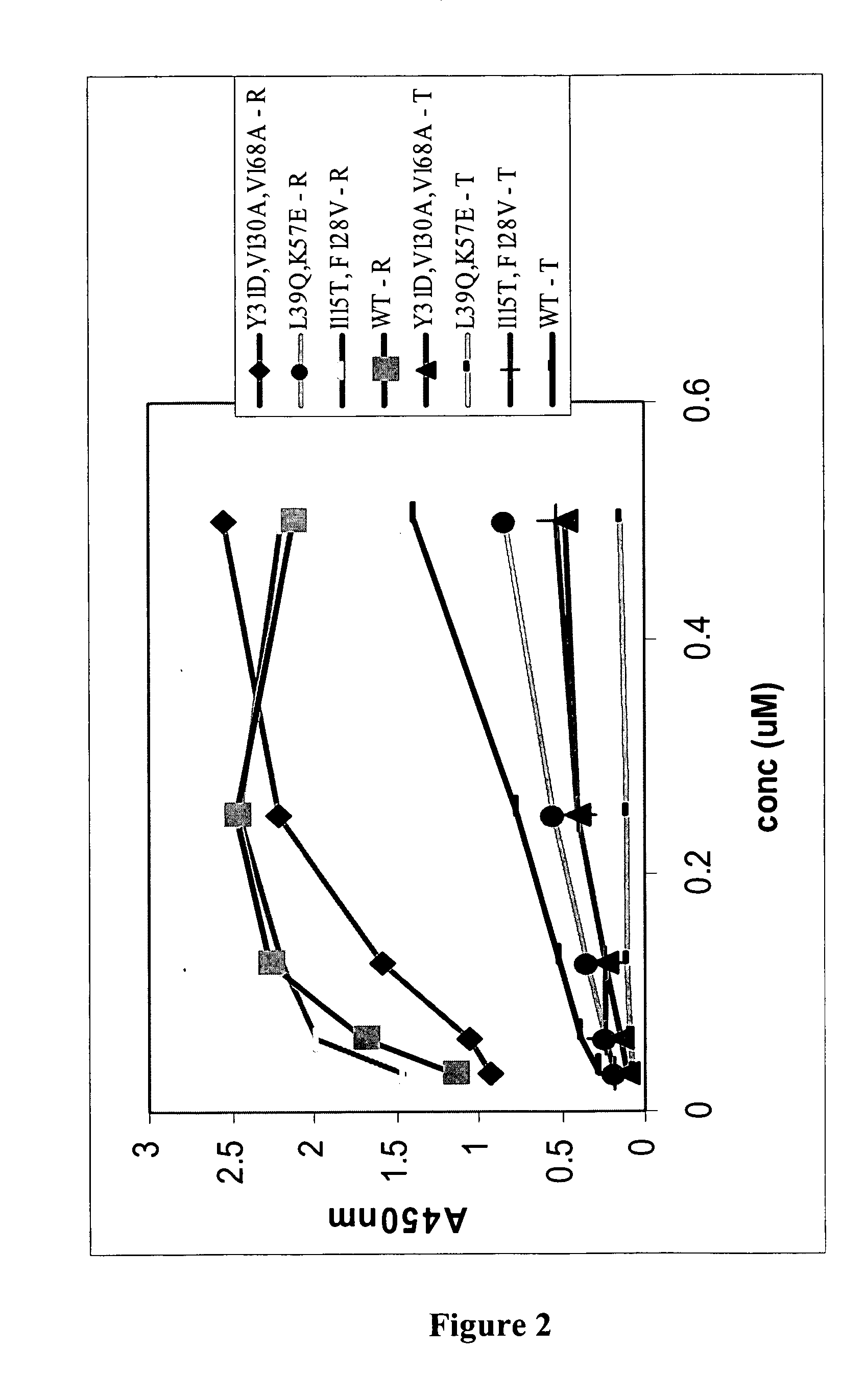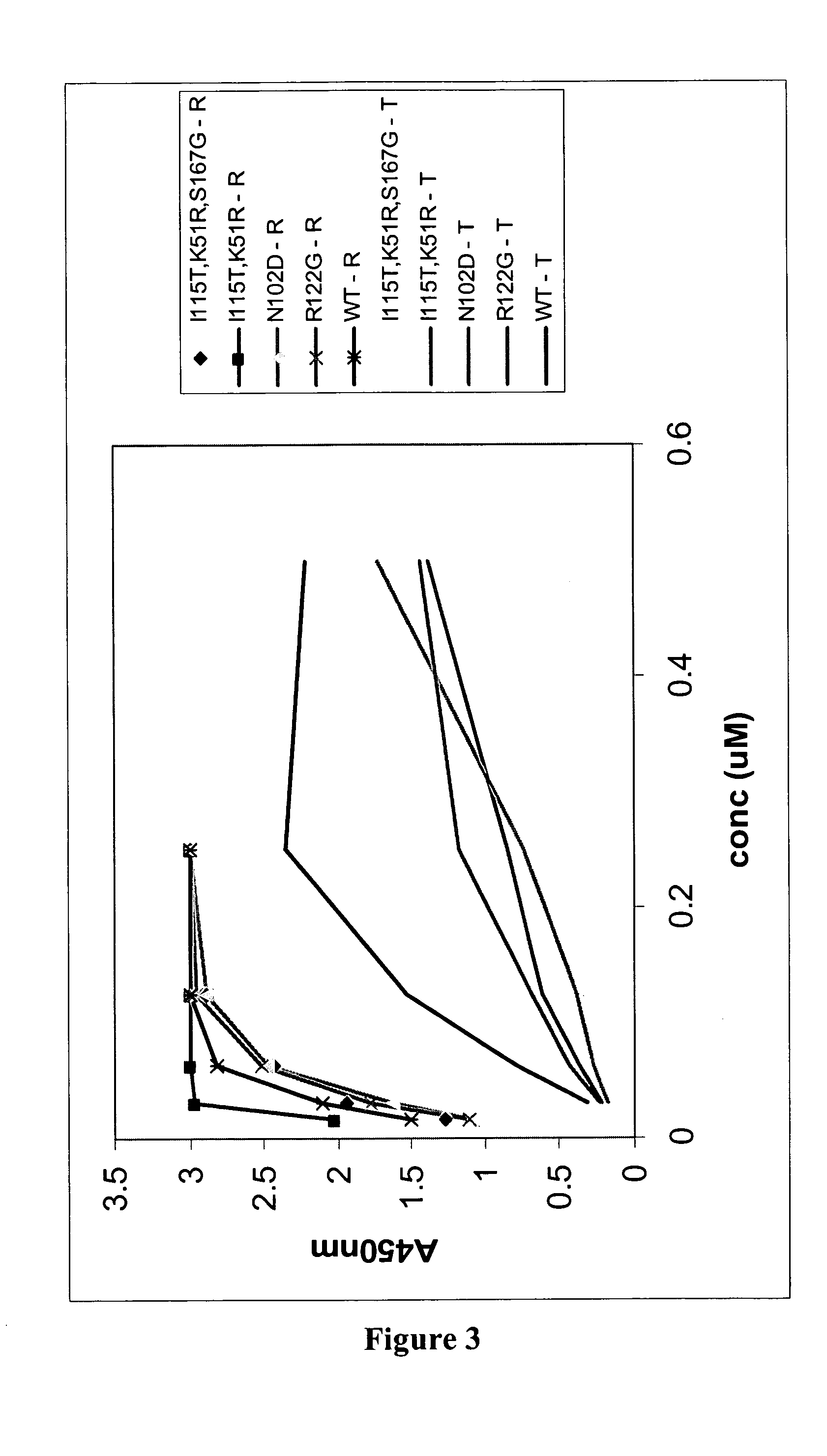Osteoprotegerin variant proteins
a technology of osteoprotegerin and variant proteins, applied in the field of evolution of proteins, can solve problems such as the possibility of increasing the risk of cancer development, and achieve the effect of reducing the ability to inhibit the normal biological effect and reducing the binding affinity of trail
- Summary
- Abstract
- Description
- Claims
- Application Information
AI Technical Summary
Benefits of technology
Problems solved by technology
Method used
Image
Examples
example 1
[0180] The gene for OPG was isolated from a human fetal kidney cDNA library (Spring Bioscience, Fremont, Calif.). Primers to the 5 and 3′ ends of the OPG sequence were designed and standard PCR used to amplify the gene. The primers used to isolate the OPG gene were:
(SEQ ID NO: 48)Forward:5′TATTACTCGCGGCCCAGCCGGCCATGAACAAGTTGCTGTGCTGCGCGCTCG 3′(SEQ ID NO: 49)Reverse:5′CATCTTTATAATCTGCGGCCGCTAAGCAGCTTATTTTTACTGATTGGACC 3′.
[0181] Overhangs in the primers incorporated restriction sites allowing cloning into suitable vectors for propagation in E. coli such as pGC (Coia et al., (1996), J. Immunol. Meth. 192:13-23) with successful cloning confirmed by DNA sequencing. In addition to the 1203 nucleotides encoding the full-length 401aa OPG protein, the OPG sequence excluding its signal peptide (aa 1-21) was amplified (OPG 22-401). The N-terminal half of the protein to aa 194, comprising the 4 Cys-rich domains, with and without its signal peptide, was also amplifie...
example 2
Generation of OPG Variant Proteins (OVPs)
[0183] To create a library of OPG variants, the OPG(22-194) DNA sequence was cloned into the pEGX mutagenesis and display vector (FIG. 1B) with confirmation by DNA sequencing. The OPG-containing plasmid (˜0.5-1.0 μg) was linearised by SmaI digestion and 100-200 ng of this was used directly as template for T7 RNA polymerase transcription at 37° C. for 16-24 h. The success of the transcription was verified by agarose gel electrophoresis loading 1 μL of the 20 μL reaction. Where possible, all manipulations involving RNA, including ribosome display, use DEPC-treated buffers, reagents, and tubes to minimise RNA degradation.
[0184] The RNA transcript is used directly as template for a replication reaction by Qβreplicase at 37° C. for 16-24 h:
volume (μL)T7 RNA transcript0.525 mM rNTPs15× T7 polymerase buffer4100 mM DTT2100 mM MgSO4 0-1.6Qβreplicase1H2010.5-8.9
[0185] The success of the replication was assessed by agarose gel electrophoresis loadi...
example 3
Panning OVPs
[0188] The complexes generated in Example 2 were panned against RANKL (Roche) and TRAIL (Peprotech) in solution. Biotinylated versions of RANKL and TRAIL were prepared using Sulfo-NHS-LC-biotin (Pierce) to enable capture of selected complexes in solution using streptavidin coated magnetic beads (Dynal).
[0189] A panning reaction was carried out in each of the three translation mix aliquots. Two different strategies were employed to create a selection pressure favouring the isolation of OVP sequences that have amino acid changes in residues that reduce binding affinity to TRAIL, whilst retaining RANKL-binding affinity. One strategy used was to first pan against soluble RANKL, and then TRAIL binders were competed off with an excess of free TRAIL protein. In one translation aliquot, biotinyl-RANKL was added at a concentration that is approximately equimolar to the amount of input RNA. This mix was then rotated for 40-60 min at 4° C. Streptavidin coated magnetic beads (Dyna...
PUM
| Property | Measurement | Unit |
|---|---|---|
| optical densities | aaaaa | aaaaa |
| volume | aaaaa | aaaaa |
| pH | aaaaa | aaaaa |
Abstract
Description
Claims
Application Information
 Login to View More
Login to View More - R&D
- Intellectual Property
- Life Sciences
- Materials
- Tech Scout
- Unparalleled Data Quality
- Higher Quality Content
- 60% Fewer Hallucinations
Browse by: Latest US Patents, China's latest patents, Technical Efficacy Thesaurus, Application Domain, Technology Topic, Popular Technical Reports.
© 2025 PatSnap. All rights reserved.Legal|Privacy policy|Modern Slavery Act Transparency Statement|Sitemap|About US| Contact US: help@patsnap.com



